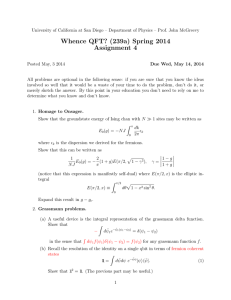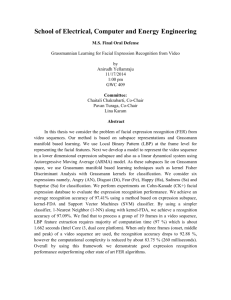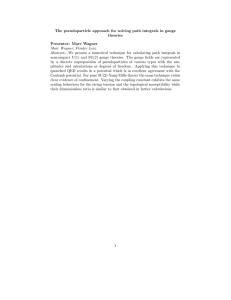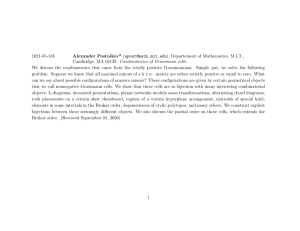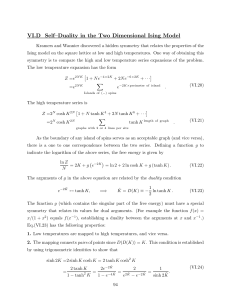Whence QFT? (239a) Spring 2014 Assignment 4 – Solutions
advertisement
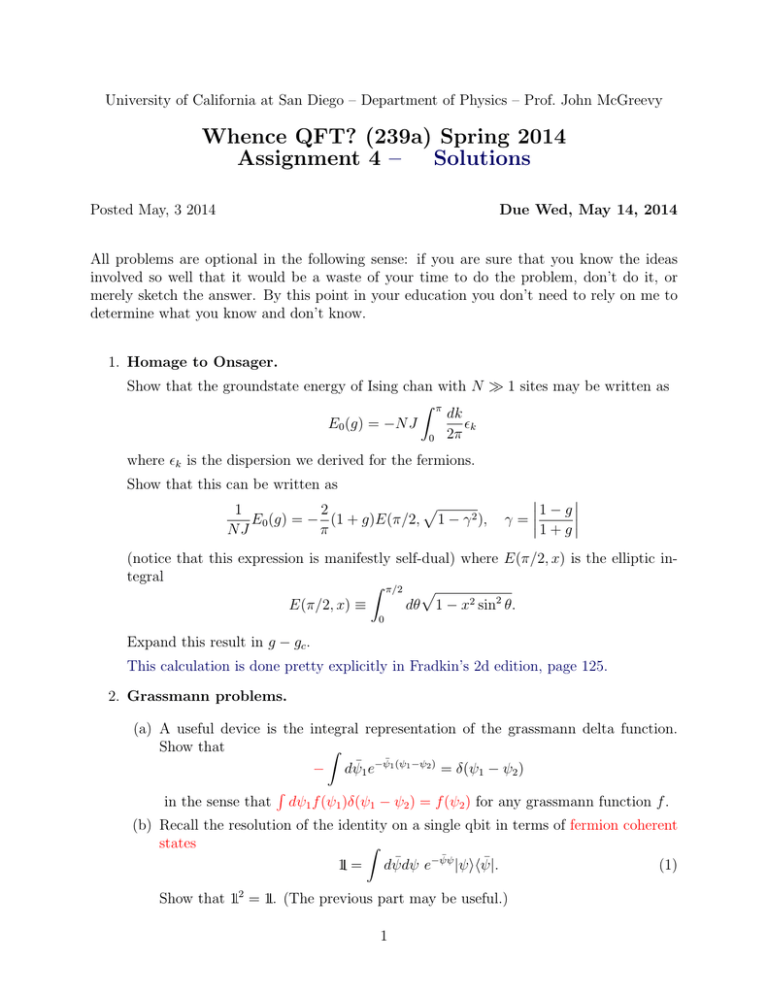
University of California at San Diego – Department of Physics – Prof. John McGreevy
Whence QFT? (239a) Spring 2014
Assignment 4 –
Solutions
Posted May, 3 2014
Due Wed, May 14, 2014
All problems are optional in the following sense: if you are sure that you know the ideas
involved so well that it would be a waste of your time to do the problem, don’t do it, or
merely sketch the answer. By this point in your education you don’t need to rely on me to
determine what you know and don’t know.
1. Homage to Onsager.
Show that the groundstate energy of Ising chan with N 1 sites may be written as
Z π
dk
k
E0 (g) = −N J
0 2π
where k is the dispersion we derived for the fermions.
Show that this can be written as
p
2
1
E0 (g) = − (1 + g)E(π/2, 1 − γ 2 ),
NJ
π
1 − g γ=
1 + g
(notice that this expression is manifestly self-dual) where E(π/2, x) is the elliptic integral
Z π/2 p
E(π/2, x) ≡
dθ 1 − x2 sin2 θ.
0
Expand this result in g − gc .
This calculation is done pretty explicitly in Fradkin’s 2d edition, page 125.
2. Grassmann problems.
(a) A useful device is the integral representation of the grassmann delta function.
Show that
Z
− dψ̄1 e−ψ̄1 (ψ1 −ψ2 ) = δ(ψ1 − ψ2 )
R
in the sense that dψ1 f (ψ1 )δ(ψ1 − ψ2 ) = f (ψ2 ) for any grassmann function f .
(b) Recall the resolution of the identity on a single qbit in terms of fermion coherent
states
Z
1 = dψ̄dψ e−ψ̄ψ |ψihψ̄|.
(1)
Show that 1 2 = 1. (The previous part may be useful.)
1
(c) In lecture I claimed that a representation of the trace of a bosonic operator was
Z
trA = dψ̄dψ e−ψ̄ψ h − ψ̄|A|ψi ,
and the minus sign in the bra had important consequences.
(Here h − ψ̄|c† = h − ψ̄|(−ψ̄) ).
Check that using this expression you get the correct answer for
tr(a + bc† c)
where a, b are ordinary numbers.
(d) Prove the identity (1) by expanding the coherent states in the number basis.
Using |ψi = |0i + ψ|1i, h − ψ̄| = h0| − ψ̄h1|, we have
Z
Z
−ψ̄ψ
dψ̄dψ e
dψ̄dψ e−ψ̄ψ (|0i + ψ|1i) h0| − ψ̄h1|
|ψihψ̄| =
Z
=
dψ̄dψ e−ψ̄ψ |0ih0| − ψ ψ̄|1ih1|
= |0ih0| + |1ih1| = 1.
(2)
3. Heisenberg chain
Consider the Heisenberg hamiltonian
X
H = −J
(Xj Xj+1 + Yj Yj+1 + vZj Zj+1 ) .
j
When v = 1 there is SU(2) symmetry. What are the generators?
P
~ j.
The generators are just the Pauli operators j σ
On the previous problem set we successfully fermionized the model with v = 0.
Fermionize the v term.
We saw (in a different basis) that this is a 4-fermion term. It is
2c†j cj − 1 2c†j+1 cj+1 − 1 .
Take the continuum limit.
Plugging in Ψ(xj ) =
√1 cj
a
gives
Z
dx 2Ψ† (x)Ψ(x) − 1 2Ψ† (x + a)Ψ(x + a) − 1
Z
2
dx 2Ψ† (x)Ψ(x) 2∂Ψ† (x)∂Ψ(x) + quadratic terms
= −Ja
∆H ' −J
Fermi statistics get rid of the term with fewer derivatives.
2
(3)
4. Counting of states
Consider the gauge theory description of the transverse field Ising model with N = 3
sites.
With open boundary conditions, find an explicit expression for the gauge transformation {sj̄ } which eliminates the original Xj variables (sets them to 1).
Since Xj̄ → sj̄− 1 Xj̄ sj̄+ 1 , we require
2
2
1 = s 1 X1 s 3 , 1 = s 3 X2 s 5 , 1 = s 5 X3
2
2
2
2
2
– there is no site to the right of X3 . So set s5/2 = X3 , s3/2 = X2 X3 , s 1 = X1 X2 X3
2
and we’re done.
Q
With closed boundary conditions, show that you cannot eliminate j Xj . Find an
expression for the gauge choice which eliminates all but one of the spins.
Q
Nothing we do with our silly ss can eliminate j Xj because it is gauge invariant.
3
